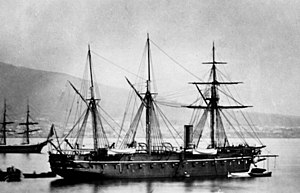Principe di Carignano-class ironclad

Principe di Carignano in Naples in 1867
|
|
| Class overview | |
|---|---|
| Name: | Principe di Carignano class |
| Builders: | |
| Operators: |
|
| Preceded by: | Formidabile class |
| Succeeded by: | Re d'Italia class |
| Built: | 1861–1871 |
| In commission: | 1865–1880 |
| Completed: | 3 |
| Retired: | 3 |
| General characteristics | |
| Type: | Ironclad warship |
| Displacement: |
|
| Length: | 72.89 m (239 ft 2 in) |
| Beam: | 15.10 m (49 ft 6 in) |
| Draft: | 7.18 m (23 ft 7 in) |
| Installed power: |
|
| Propulsion: | One single-expansion steam engines |
| Speed: | 10.4 knots (19.3 km/h; 12.0 mph) |
| Range: | 1,200 nmi (2,200 km) at 10 kn (19 km/h; 12 mph) |
| Complement: | 572 |
| Armament: |
|
| Armor: | Belt armor: 4.75 in (121 mm) |
The Principe di Carignano class was a group of three ironclad warships built for the Italian Regia Marina (Royal Navy) in the 1860s. The class comprised the ships Principe di Carignano, Messina, and Conte Verde. Originally ordered as wooden frigates, they were the first ironclads to be built in Italy, but the inexperience of the Italian shipyards and the redesign process produced lengthy construction times, such that only the lead ship was completed in time to see action during the Third Italian War of Independence in 1866. The first two ships were protected by a complete belt of wrought iron plating that was 4.75 inches (121 mm) thick, while Conte Verde only received a partial iron belt.
Principe di Carignano took part in the Battle of Lissa on 20 July 1866, where she led the Italian line of battle, but was not heavily engaged. Rendered obsolescent by the advent of central battery and turret ships in the 1870s, the three Principe di Carignano-class ships did not have particularly long or active service lives. In an effort to reduce the maintenance budget to offset the cost of newer ships under construction, Principe di Carignano was stricken from the naval register in 1875; Messina and Conte Verde followed in 1880, the latter just nine years after completion.
The first two vessels of the Principe di Carignano class were initially ordered as steam frigates by the Regia Marina Sarda (Royal Sardinian Navy) shortly before the unification of Italy. While they were on the stocks, the Regia Marina (Royal Navy) of the newly-formed Kingdom of Italy decided to convert the ships into ironclads. A third ship, Principe Umberto, was too far advanced in her construction to allow for conversion, and so she was completed as a wooden vessel. These ships had been designed by Inps. Eng. Felice Mattei. A fourth ship, Conte Verde, was built to a modified design created by Inps. Eng. Giuseppe De Luca. These ships came as part of a major naval expansion program that was designed to prepare a fleet of ironclads capable of defeating the Austrian Navy. Italy considered the Austrian Empire to be its main rival, since it controlled predominantly Italian areas, including Venice.
...
Wikipedia
